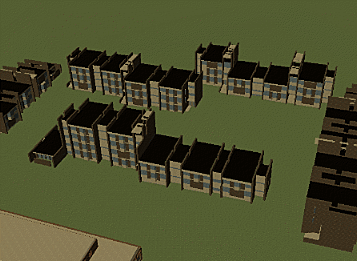3. The Second Wave
Expansion at the Periphery

Princeton University. Property of the Trustees of Princeton University.
Location -- the top priority issue for the first wave of buildings in the 1960s -- was less significant with the latter structures of the decade. The old in-fill strategy on the main campus had caused some controversy with the construction of the E-Quad, which had absorbed the beloved University Field, and of the architecture building, which encroached on Prospect House. In the second half the 1960s, however, Princeton expanded on the periphery.
Jadwin/Fine Tower Complex

Princeton University. Property of the Trustees of Princeton University.
The Jadwin Physics/Fine Tower complex was erected in the same quadrant of the campus, with the New New Quad dormitories sprawling south onto the playing fields. But if location played a lesser role, architectural style became more important.
Compensating for the blandness the structures of the early 1960s, by mid-decade the University had unveiled a further iteration of the campus master plan that included several dramatic new buildings. In particular, the designs for Jadwin Gymnasium, the Woodrow Wilson School, and the Jadwin Physics/Fine Tower complex reflect a departure from the stylistic monotony of the earlier wave of '60s buildings.
Although not especially memorable or influential designs by any means, they were considerably more bold than their immediate predecessors. And they have important institutional relevance. These structures and the outsiders who designed them reflect the weakening of the grip of the old-guard trustees on the Buildings and Grounds Committee. It became clear that Princeton could not -- and should not -- indefinitely evade the architectural revolution taking place in the outside world.
New New Quad Vintage CAD

Princeton University. Property of the Trustees of Princeton University.
To a slightly lesser extent, the second wave of new dormitories mirrored this stylistic shift. To accommodate the demand for yet more dormitory space, especially single rooms, Princeton added an additional five-building group of dorms, Lourie-Love,1922, 1940, 1941, and 1942, imaginatively called New New Quad (now Butler College).
The dorms of New New Quad used darker bricks and more ornamentation than New Quad, and the scale was more intimate.
Spelman Hall

Princeton University. Property of the Trustees of Princeton University.
But the other dorm dating from this period, Spelman Hall, was much more stylistically daring. Designed by I.M. Pei, the stark white and glass triangles of Spelman (commissioned in 1971) contrasted sharply with the Collegiate Gothic of neighboring Pyne Hall and Dillon Gymnasium.
Spelman also represents a significant cultural departure for Princeton. Indicative of the times, it allocated space for married student housing and the inclusion of kitchenettes in each suite was symbolic of the increasing number of "independents." (Eating club membership bottomed out in this period.) The implicit emphasis on self-reliance and suite living marked a far cry from the idea of the communal residential university, as conceived by Wilson and West.
Spelman was also the last of the four dozen buildings conceived, designed, built, or acquired during the Goheen presidency, and it serves as a remarkable structure marking the end of a decade of explosive growth. The onset of harder economic times in the 1970s and early 1980s drastically curtailed the building program of Goheen's successor, William Bowen *58. Furthermore, as Bowen discovered, Princeton's now-enormous physical plant required constant and expensive maintenance. And the University had only just begun to cope with the physical plant problems attendant with the decision to admit women.
More than 10 years passed before the beginning of another fundraising drive, "The Campaign for Princeton", which enabled the University to upgrade its facilities on a meaningful scale. But this time was not idly spent. Under Bowen's guidance, in the 1970s, the University grappled with several core questions about student life and the University's mission that trace back to the turn of the century. With the growth of the campus, these issues had become more pressing. The recommendations of the group assigned the task of sorting it all out, the Committee on Undergraduate Residential Life, or CURL, are still having a major impact on Princeton's architectural landscape today.


Jadwin Gym, for instance, was built on the bluffs above Lake Carnegie and south of Palmer Stadium.